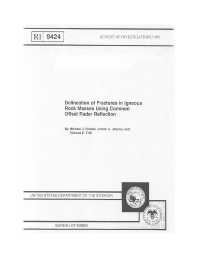Mining Publication: Delineation of Fractures in Igneous Rock Masses Using Common Offset Radar Reflection
Original creation date: January 1992
As part of an investigation aimed at improving the health and safety and competitiveness of the mining industry, the U.S. Bureau of Mines evaluated the application of common offset radar profiling, using a 250-MHz ground-penetrating radar (GPR) system, for the detection of fractures in igneous rock. A series of radar reflection surveys were conducted to detect and delineate the extent of fracturing at various granodiorite and gabbro quarries and outcrops located in Minnesota. The application of radar profiling for detecting joints, sheeting fractures, shear zones, and depth to water table was demonstrated to be feasible with minimal processing. Radar reflection interpretations were verified by visual inspection of the rock mass and field mapping of local structure. The radar reflection section provides a simple, rapid, and cost-effective means for mapping of shallow (less than 10 m) small-scale fractures (greater than 0.25 cm) in igneous rock masses (characteristic of velocities between 0.061 m/ns for gabbro and 0.125 m/ns for granodiorite). Depth or distance estimates to fractures are within 10 pct of the actual, and time-shift compensation is necessary only when topographic irregularities exceed 30 cm.
Authors: MJ Friedel, JA Jessop, RE Thill
Report of Investigations - January 1992
NIOSHTIC2 Number: 10011399
U.S. Department of the Interior, Bureau of Mines, Report of Investigations 9424, 1992 Jan:1-15
See Also
- Application of Ground Penetrating Radar to Evaluate the Extent of Polyurethane Grout Infiltration for Mine Roof Control: A Case Study
- Coal Mine Geology in the U.S. Coal Fields: a State-of-the-art
- Managing Excess Gas Emissions Associated with Coal Mine Geologic Features
- Technology News 462 - Ground Penetrating Radar for Highwall Guidance
- Use of Ground Penetrating Radar and Schmidt Hammer Tests to Determine the Structural Integrity of a Mine Seal
- Content source: National Institute for Occupational Safety and Health, Mining Program


 ShareCompartir
ShareCompartir
